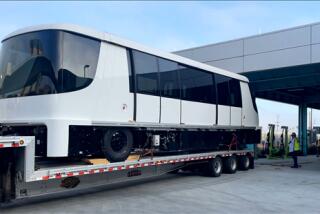Hot Hogs Find Outpost a Cool Place to Visit
- Share via
DRY LAKE, Nev. — Gail Magleby, 60, drives 36 miles from his Las Vegas home to this ghost town five days a week to water hogs.
The hogs don’t live here. They’re just passing through.
They’re riding Union Pacific’s “Ham” train. Some call it “Hamtrack”--the last regularly scheduled livestock train operating in the United States.
Magleby and his son, Mike, 30, who helps out on busy days, are the only two railroad hog waterers in America.
Until World War II, most livestock was shipped by train. Now, cattle, sheep and hogs are transported by truck from farms, ranches, auction yards and stockyards to packing houses.
But 1,500 to 3,000 hogs are still shipped each weekday from the Midwest to the Farmer John packing plant in Vernon in Southern California on the “Ham” train.
The hogs in the triple-deck, 40-foot-long cars are sprayed with water to give them relief from the desert heat and are given water to drink on a siding off the railroad’s main line tracks here.
First the train slows to less than 5 m.p.h. as it passes through “drenchers”--nozzles mounted on standpipes on both sides of the track spraying water on the cars loaded with hogs. It looks like a car wash.
Because it is so hot in the desert during summer--it was a blistering 110 degrees this day--the train backed up, giving the hog cars a second drenching, and later, on the way out, a third blast of water.
Gail Magleby, working alone, hooked up hoses to each hog car, opened valves on the water line beside the track and flooded troughs inside the cars with drinking water for the animals. It was a small load--only nine cars with a total of 1,854 hogs. The three-diesel-engine train pulled 30 other cars of general freight. The average “Ham” train has 15 carloads of pigs.
When the train rolled into Dry Lake, the hogs were grunting loudly. After being sprayed and given water to drink, they quieted down.
“The ‘Ham’ train is one of the hottest trains in the country,” explained conductor Mac Thompson, 58, who has spent 40 years on freight trains between Milford, Utah, and Las Vegas.
“It’s a hot train because the whole idea is to move it along as fast as possible because of the load. We carry hogs, U.S. mail, a lot of perishables and other freight that has a priority to get to its destination in a hurry.”
The train rolls along at 70 m.p.h. across open country.
“We’ve got to stop at Dry Lake to water the hogs before crossing the Nevada and California deserts. These pigs would melt in this heat if we didn’t,” said Thompson, wiping the sweat from his brow.
It took Magleby 35 minutes to water down the hogs, then the train was once again on its way, high-tailing it to Vernon.
Dry Lake was a tiny desert railroad town until it was abandoned about 10 years ago. It had a post office, gas station, store and one-room school.
Little Left of Town
Now the school, its windows broken, yellow paint faded, is home to about 50 pigeons. The dozen homes in the community are falling apart, victims of the elements.
Water for the hogs comes from a 70,000-gallon water tank erected in the 1920s and used to water the old steam engines until diesels replaced them after World War II. The water is pumped from two wells.
The hogs are shipped to Farmer John from 11 Midwest auction centers--six in Nebraska, two in Missouri, one each in Iowa, South Dakota and Colorado. Shelled corn is spread throughout the cars for food. The animals bed down on sand.
More to Read
Sign up for Essential California
The most important California stories and recommendations in your inbox every morning.
You may occasionally receive promotional content from the Los Angeles Times.













